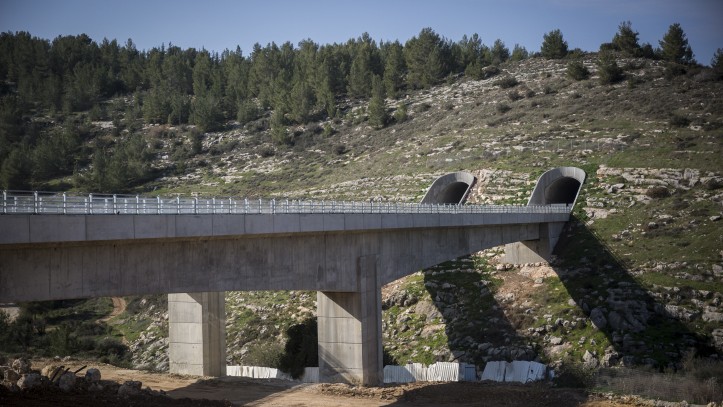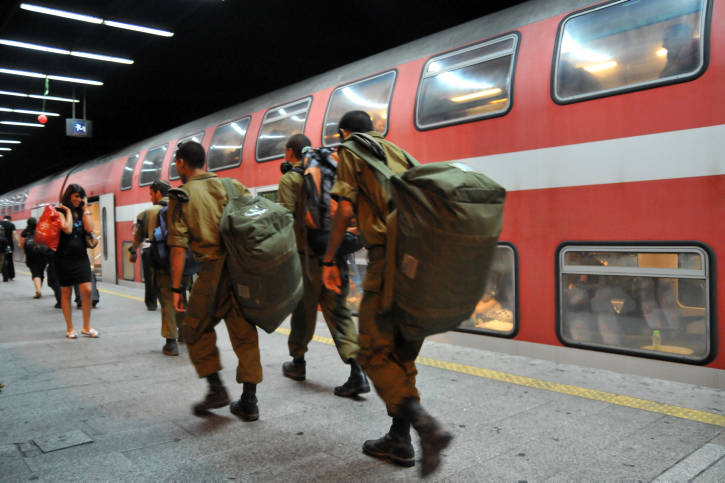Since I
mentioned in my last post that I’m travelling to Tel Aviv four times a week,
perhaps a post on the excellent public transport system in Israel would be in
order.
 |
| There's no joy for drivers in Tel Aviv. Some other Israeli cities are just as bad. |
Most Israelis own
and drive private automobiles, and even the two-car family has become quite
commonplace here. This is sign of increasing
prosperity; 25 years ago, the family with one car was doing
better-than-average. Now, with a
population that is growing about 2% per year and a mushrooming car ownership
rate, the country’s roads are considerably congested. It is said that Israel has the most cars per
kilometer of road of any country in the world, except Singapore. The problem of traffic density is exacerbated
by the smallness of the country, which makes families reluctant to move house
when a breadwinner takes a job in another city.
Since most Israeli cities are within commuting distance of one another,
most will just plan to commute and stay put.
Because Israelis treasure personal mobility as much as any other people, this means there are a lot of cars on the road on any given
weekday.
In another,
future post I’ll deal with the realities of driving in Israel. For now, suffice it to say that it can be a
frustrating, as well as expensive, proposition.
 |
| Israel Railways' Ashqelon Station at dawn. |
Thank goodness
there is an excellent public transport network consisting of countrywide ‘heavy’
rail as well as light rail within Jerusalem (and soon, Tel Aviv), plus a number
of intercity bus companies as well as local bus lines in every city and many towns. Except on the Sabbath and religious festivals, it
is possible to travel just about anywhere in the country via public
transport. For door-to-door service,
there are legions of taxis. No Uber
though: the ride-sharing company was just
getting started in Tel Aviv, but the government has made their service
illegal. There is an app-based ride
hailing service called ‘GETT,’ but its vehicles are regular licensed taxis.
 |
| Most of Israel's rail lines run down the center of highways. |
Newcomers to
Israel frequently find themselves frustrated by the casual, ‘it’ll start when
it starts’ attitude toward timeliness. I
certain do, especially given my military background! But one thing that seems to operate with
almost German-like precision, is the train network. I can’t say as much about the buses, simply
because they have to cope with the same traffic congestion that every driver
must endure, so bus travel is usually fraught with delays.
 |
| The entrance-exit turn-styles in the busy Tel Aviv Center Station |
So, I’ve been
taking the train every morning – four days a week – to Tel Aviv. It’s about an hour’s ride, and the trains
mostly do run on schedule. The train
cars on the main north-south coastal routes, are double-decker with lounge-type
seating that is reasonably comfortable for trips that are seldom over two
hours. A standard consist seems to five
cars, pulled or pushed by a single diesel locomotive. Several of the lines that run inland, use
single-level cars that are self-propelled (diesel). A contract was recently signed to purchase
electric trains from the German company Siemens, to replace the diesels as the
various lines are electrified. The
Israeli trains are not high-speed a la the Bullet Train, but I have
clocked trains running at over 100 KM/H where the tracks parallel a highway as they
do over most of the network. There is
a ‘high speed’ track under construction on the Tel Aviv-Jerusalem corridor that
will cut the time of the trip down to something like half an hour when it
opens.
 |
| Whimsical touches abound. Every train station has a piano for whoever wants to sit down and play. I've heard some really good music when passing through the stations. |
The trains are
very inexpensive to ride; my daily round trip fare from Ashqelon to Tel Aviv
would be NIS 22 (US $6.27 at today’s exchange rate), or NIS 27 (US $7.70)
including the bus trip within the Tel Aviv area. But I buy a monthly pass which includes the
buses at either end, with unlimited use during the month for NIS 423 (US
$120.00). In addition to the unlimited
aspect of this pass, an additional benefit is that I can breeze right into the
station and through the turn-style, without needing to buy a ticket from one of
the vending machines of the live cashier each day. And on the buses, I just hold my chip card
against the fare machine for a second until it registers. It’s a very easy way to get around.
 |
| The new Tel Aviv-Jerusalem high speed rail line is an engineering marvel and will make travel between Israeli's two largest cities much faster. |
In addition to
having small tables for getting work done or holding drinks, the trains usually
have 220V A/C plugs at the seats, for powering/recharging electronic
devices. The cars also have free WiFi
for underway surfing. There are
restrooms in every car. Finally, there
are limited spaces for bicycles, and bicycles (including electric bikes) are
carried free. During rush hours, you’re
only supposed to bring folding bikes aboard, but this is a rule generally
ignored. There are no other services on
board, though; one must buy food or drink to be consumed on the way, before
boarding.
 |
| A familiar sight on Israel Railways, is that of soldiers travelling with full kit. Even when in combat readiness, they usually go home on leave every second weekend. |
Rush hour
trains can be standing room only, but I go to Tel Aviv before the morning rush
and come home before the afternoon rush, so the trains are never so crowded. When I arrive in Tel Aviv, I never have to
wait more than a few minutes for the bus that takes me to a block-and-a-half
from Ulpan Gordon, and the ride takes perhaps 20 minutes.
If I chose to
travel by car to Tel Aviv, there would always be danger of traffic bottlenecks,
not to mention the problem of finding parking in Tel Aviv.
 |
| Buses as Ashqelon's Central Station |
I have also traveled between cities by bus, generally when I go to Jerusalem as there is a
direct bus from Ashqelon but going by rail would require two train changes and
considerably more time. Except for being
subject to traffic congestion, bus travel is also pleasant enough; the buses
are comfortable and run often, the fares are cheap like the train fares, and
the buses have USB power at each seat and free WiFi. From Ashqelon to Jerusalem, the bus takes
about 90 minutes.
I have to say that
I find getting around in Israel by public transport, easier and cheaper than
anywhere else I’ve lived (including Germany).
While there are aspects of life in Israel that can make you want to tear
the hair out of your head in frustration, getting around is generally not one of them!
That is valuable information about public transport in Israel. I’m sad that capitalism is restricted. Uber provides cheap transport. Employs the unemployable in many cases. And because of lower costs, saves lives. Drink driving drops dramatically when Uber is allowed to operate. The biggest problem for Government with Uber, is that people of different age groups and demographics get to communicate and realise that, “we the people” is more powerful than the government
ReplyDeleteHow is the course going ?
Going well, thanks, Paul! Yes, you're not the only one unhappy about Uber's inability to operate in Israel. Generally speaking, Israel's economy is highly-regulated. I'll address that in depth in a future post!
ReplyDelete